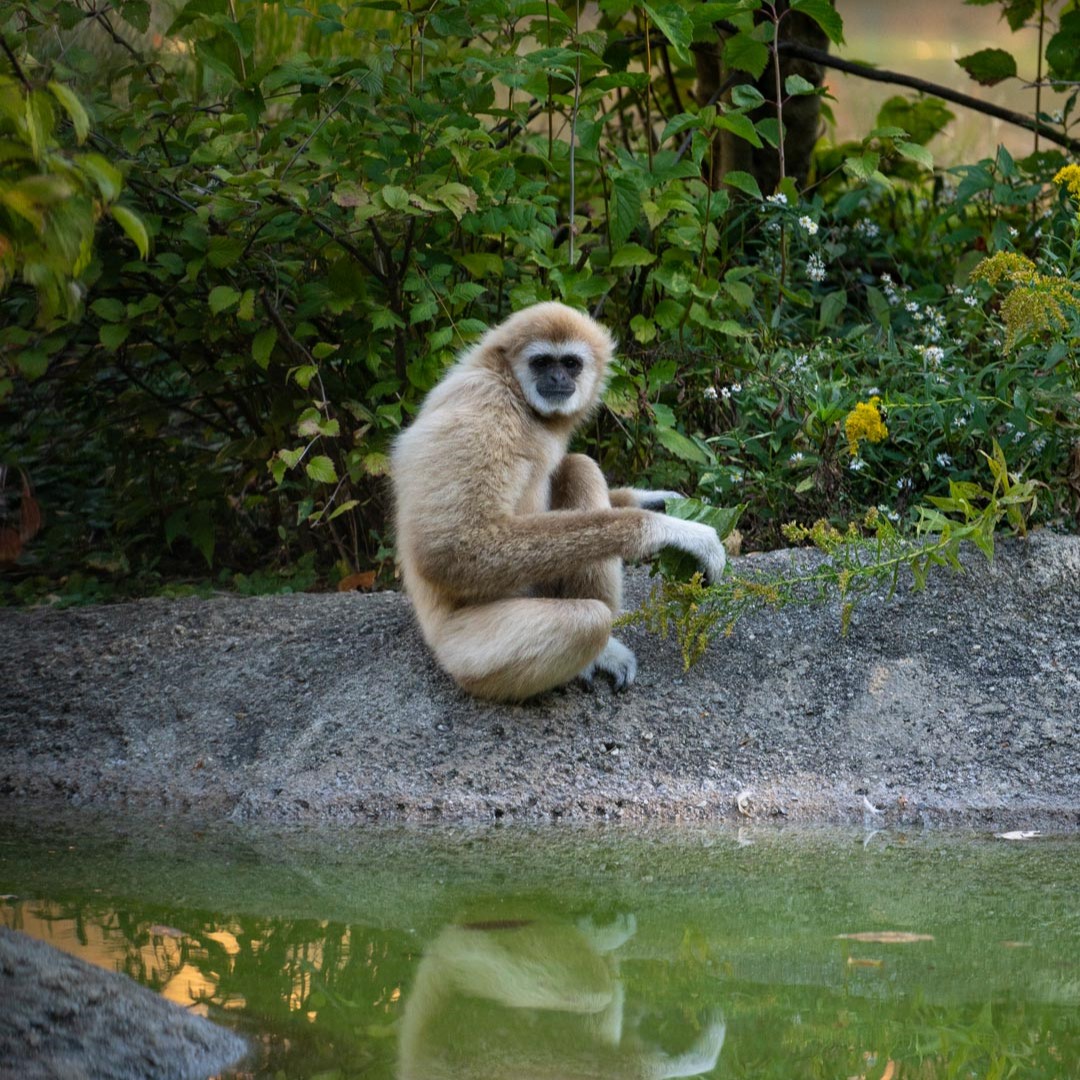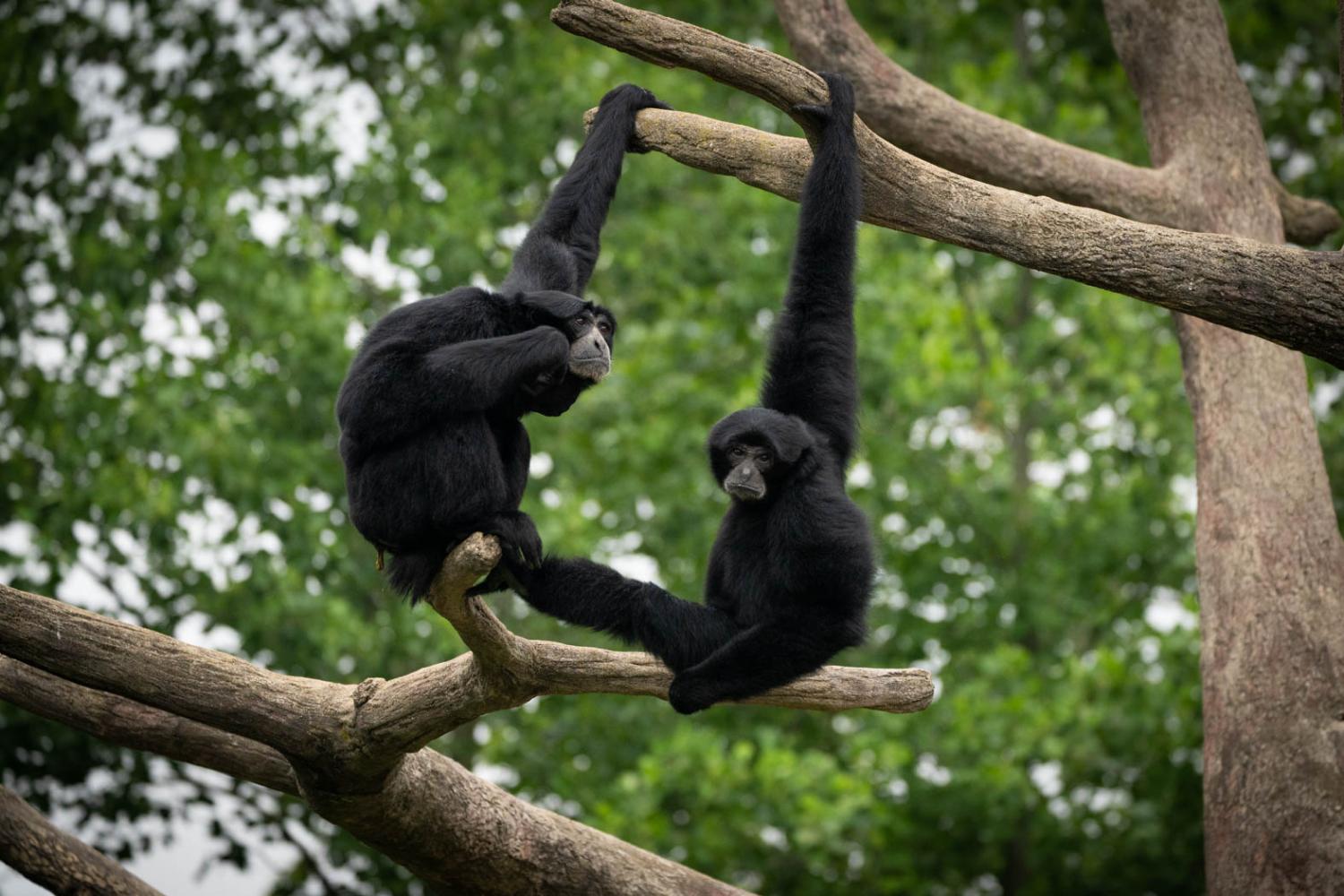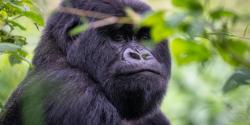If you've visited the Columbus Zoo, you have probably heard this species' very recognizable vocalizations as they echo throughout the entire Zoo. Today, we're "gibbon" you a blog dedicated to two species of gibbons—the whitehanded gibbon and the siamang.
Let's meet the Zoo's gibbons!
White-handed gibbon family

- Chanee (mom): She is 17 years old and was born here at the Columbus Zoo. She is very strong willed and knows what she wants. Her and Leo are very bonded and she’s frequently involved in grooming sessions with her family. Her coat is black.
- Leo (dad): He is 12 years old and came to the zoo in 2016 to hopefully breed with Chanee. They got along great instantly! He’s very spunky and is usually seen keeping an eye on things for his family or playing with JC. His coat is light brown/tan.
- Siena (daughter): She is 6 years old and was born here to Chanee and Leo. She has a very calm and sweet demeanor about her. We recently learned that she loves looking at herself in any mirror enrichment! Her coat is black.
- JC (daughter): She is 4 years old, also born here to Chanee and Leo. She is rambunctious and is very often seen playing with her family or interacting with enrichment. She is very weary of new people and takes a while to trust keepers at first. Her coat is light brown/tan.
White-handed gibbons are found in tropical rainforests of Southeast Asia and inhabit semi-deciduous monsoon forests and tropical evergreen forests. They occupy only the upper canopy, and this species rarely, if ever, descends to the forest floor.
While they are primarily frugivorous (fruit eating), the white-handed gibbon will also eat leaves, flowers, stems, shoots, buds, insects, and eggs. They can be very selective feeders when it comes to fruit consumption: fruits are tasted and either accepted or rejected based on ripeness!
They have several adaptations for feeding. One of them is brachiating locomotion, which involves swinging from branch to branch by their arms. This style of motion allows them to reach the periphery of the tree canopy, where most of their food is found.
Additionally, white-handed gibbon communication is incredibly fascinating. They communicate using term songs, which are combinations of solos and/or duets performed by bonded pairs. Their calls are loud, long, and complex-- they average 11 minutes and can be heard up to one kilometer away!
Sadly, white-handed gibbons are now considered the most threatened species of primate. They are listed as Endangered according to the IUCN. It is possible that their species will be the first ape extinction to occur within this generation. The major threats to this species include hunting and habitat destruction as major threats, followed by other contributing factors including illegal wildlife trade.
Siamang family

- Rashid (dad): He is 32 years old and a sweet, gentle old man. He is very loving and patient with Tamarack and is frequently seen playing with him throughout the day. He’s known for carrying food around in his feet (something Tamarack picked up on and does as well!) and loves the “butt” end of lettuce.
- Tamarack or T for short (son): He is 3 years old and is a crazy and wild youngster. He loves interacting with enrichment and getting on his dad’s nerves. He has a great relationship with the keepers that work with him and is quick to learn new training behaviors! He has started to call with his dad since mom, Olga, passed away. He’s just as sweet as his dad and is starting to show a little bit of his Olga’s features in his face.
Known for its graceful movement through the trees and impressive emotive calls, the siamang are the largest of the gibbons, sometimes referred to as the ‘lesser apes.’
Siamang often reaches double the size of other gibbon species and have webbed digits, distinguishing them even further from other gibbons. The enlarged throat sac is the most distinguishing characteristic of siamangs and can be as big as a human head! These throat sacs are used as a sound box to amplify their loud vocalizations.
Siamang sleep during the day, upright on branches with their arms folded and head between their knees, unlike great apes who build sleeping nests or platforms. Awake at dawn, the family communally defecates shortly thereafter, then perform their morning “concert,” before setting out to search for food, taking about 3-4 hours to eat their fill. They tend to rest more than 50% of their waking period (dawn to dusk). At night, the group enters the highest branches of a single tree to sleep.
Siamang are considered endangered, with the population declining by 50% over the past 40 years because of the pet trade and continued rates of habitat loss.
What can you do to help?
As consumers, we have direct impact on the survival of this species. The companies that we support, the products we buy, and the everyday actions that we take do make a difference. You can learn more about how to make well-informed and eco-friendly choices in everyday life that support wildlife and the preservation of their habitats on our website: https://www.columbuszoo.org/everyday-actions










